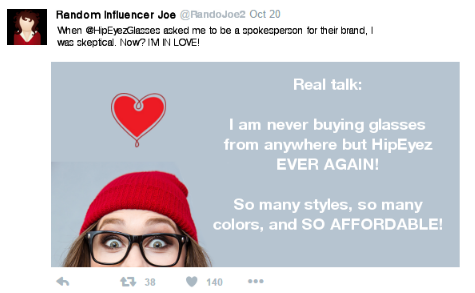It was only a matter of time. As folks became celebrities through non-traditional means, brands jumped at the opportunity to have these influencers promote their products and services. This flavor of influencer marketing, seen most frequently via social media, is really just an old twist on celebrity spokespeople.
The difference is that those celebrities were (almost) always bolstering brands in overt marketing — things like TV commercials or magazine print ads. There was no mistaking their appearances as individual, independent endorsement of a brand.
When such endorsements are scattered throughout an individual’s personal Twitter feed, though, it becomes more difficult to tell the difference. You have to wonder: is that person with 500k followers really in love with that skincare line? Or are they getting paid to promote it? In most cases, you’re not going to see that influencer saying, “Buy this! And by the way, I’m getting paid to say that.”
And herein lies the problem. By law, these influencers are required to disclose their relationship to a brand if they’re being paid to promote it — something that’s awfully difficult to do when you’re working with 140 characters. But difficulty does not excuse one from compliance, and influencers might find themselves in perilous waters moving forward if they don’t follow the rules.
On the heels of an FTC settlement earlier this year by Lord & Taylor for failing to ensure sponsorship disclosure by contracted influencers, advocates have filed yet another complaint against multiple companies for similar tactics when targeting children. If the FTC’s past behavior is any indication, they’ll be sympathetic to the advocates’ arguments, and any complaints that come up in the future.
So how can marketers protect themselves? How can influencers stay out of trouble? How can this be accomplished without compromising the authentic voices that make influencer marketing so valuable?
The answer is design.
You might not want to waste 20+ characters on a text callout of the sponsorship, nor would you want to immediately associate your endorsement with a payday. But if you share your promotion with an image attached, you can disclose the relationship without totally undermining the message or wasting precious characters.
A banner or icon at the bottom of your selfie can do the heavy lifting instead. A frame around your short video can do the same. This lets you say what you want to say, show off your enthusiasm, and still stay on the right side of the law.

If you’d rather give yourself more space to talk about the product, a well-designed quote graphic with similar disclosure can keep you in the clear, too. This can be particularly useful if you want to disclose the relationship in a more conversational manner.

You can also invert this option. Instead of using the text of your tweet or Instagram post to love on a brand, have a graphic designed that communicates your enthusiasm and use the text to casually reveal the relationship. In some cases, the brand might be able to provide such an image on your behalf. And if you’re a brand trying to leverage influencer marketing, having such collateral ready to go can help you maintain some creative control over the message.

One way or another, those participating in influencer marketing are going to have to find a way to comply with the law. Fortunately, with a little creativity, everyone can walk away satisfied.



0 Comments